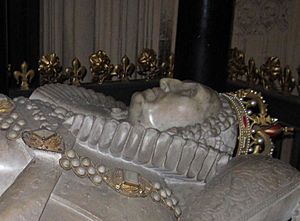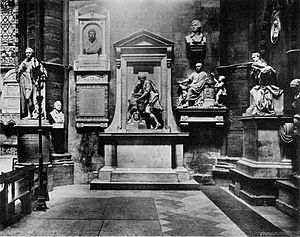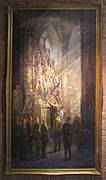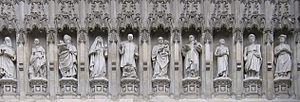Burials and memorials in Westminster Abbey facts for kids
Honouring individuals with burials and memorials in Westminster Abbey has a long tradition.
Contents
History
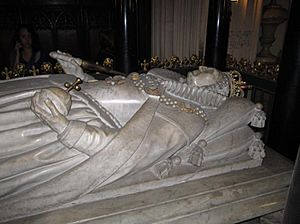
Henry III rebuilt Westminster Abbey in honour of the Royal Saint Edward the Confessor whose relics were placed in a shrine in the sanctuary and now lie in a burial vault beneath the 1268 Cosmati mosaic pavement, in front of the High Altar. Henry III himself was interred nearby in a superb chest tomb with effigial monument. Many of the Plantagenet kings of England, their wives and other relatives, were also buried in the Abbey. From the time of Edward the Confessor until the death of George II in 1760, most Kings and Queens of England were buried here, although there are exceptions (most notably Edward IV, Henry VIII and Charles I who are buried in St George's Chapel, Windsor Castle). All monarchs who died after George II were buried in Windsor; most were laid to rest in St George's Chapel, although Queen Victoria and Edward VIII are buried at Frogmore, where the Royal Family also has a private cemetery.
Since the Middle Ages, aristocrats were buried inside chapels, while monks and other people associated with the Abbey were buried in the Cloisters and other areas. One of these was Geoffrey Chaucer, who was buried here as he had apartments in the Abbey where he was employed as master of the King's Works. Other poets, writers and musicians were buried or memorialised around Chaucer in what became known as Poets' Corner. These include: W. H. Auden, William Blake, Robert Burns, Lord Byron, Charles Dickens, John Dryden, George Eliot, T. S. Eliot, Thomas Gray, Gerard Manley Hopkins, Samuel Johnson, John Keats, Rudyard Kipling, Jenny Lind, John Masefield, John Milton, Laurence Olivier, Alexander Pope, Nicholas Rowe, Percy Bysshe Shelley, Thomas Shadwell, Alfred, Lord Tennyson and William Wordsworth. Abbey musicians such as Henry Purcell were also buried in their place of work.
Subsequently, it became one of Britain's most significant honours to be buried or commemorated here. The practice of burying national figures in the Abbey began under Oliver Cromwell with the burial of Admiral Robert Blake in 1657. The practice spread to include generals, admirals, politicians, doctors and scientists such as Isaac Newton, buried on 4 April 1727 and Charles Darwin, buried 19 April 1882.
Eight British Prime Ministers are buried in the Abbey; William Pitt the Elder, William Pitt the Younger, George Canning, Henry John Temple, 3rd Viscount Palmerston, William Ewart Gladstone, Bonar Law, Neville Chamberlain and Clement Attlee.
During the early 20th century, for reasons of space, it became increasingly common to bury cremated remains rather than coffins. In 1905 the actor Sir Henry Irving was cremated and his ashes buried in the Abbey, thereby becoming the first person ever to be cremated prior to interment. This marked a milestone as after the death of Sir Joseph Hooker in December 1911, the Dean and Chapter of Westminster Abbey chose to offer Hooker a grave near Charles Darwin's in the nave but also insisted that he be cremated before. His widow however declined and so Hooker's body was buried in the churchyard of St Anne's Church, Kew. The majority of interments at the Abbey are of cremated remains, but some burials still take place – Frances Challen, wife of the Rev Sebastian Charles, Canon of Westminster, was buried alongside her husband in the south choir aisle in 2014. Members of the Percy family have a family vault, "The Northumberland Vault", in St Nicholas's chapel, within the Abbey. The ashes of physicist Stephen Hawking were interred in the Abbey on 15 June 2018, near the grave of Sir Isaac Newton. The memorial stone, bearing the inscription 'Here lies what was mortal of Stephen Hawking 1942–2018', includes a form of the Bekenstein–Hawking entropy equation relating to black holes.
In the floor just inside the great west door, in the centre of the nave, is the tomb of The Unknown Warrior, an unidentified British soldier killed on a European battlefield during the First World War. He was buried in the Abbey on 11 November 1920. There are many graves in the floors of the Abbey, but this is the only grave on which it is forbidden to walk.
Burials
- See also: Category:Burials at Westminster Abbey
British Monarchs and Consorts
The following English, Scottish and British monarchs and their consorts are buried in the Abbey:
- Sæberht of Essex (possibly)
- Edward the Confessor and Edith of Wessex
- Henry III of England (Eleanor of Provence buried at Amesbury)
- Edward I of England and Eleanor of Castile
- Edward III of England and Philippa of Hainault
- Richard II of England and Anne of Bohemia
- Henry V of England and Catherine of Valois
- Possibly Edward V of England and his brother, Richard, Duke of York (The so-called Princes in the Tower; remains exhumed from the Tower of London and entombed in 1674)
- Anne Neville, wife of Edward of Westminster (1470-71; buried at Tewkesbury) & Richard III (1472-85; buried at Leicester Cathedral)
- Henry VII of England and Elizabeth of York
- Edward VI of England
- Anne of Cleves, wife of King Henry VIII (buried at Windsor with Jane Seymour)
- Mary I of England
- Mary, Queen of Scots, mother of James VI & I (brought from Peterborough Cathedral in 1612)
- Elizabeth I of England
- In the 19th century researchers looking for the tomb of James I partially opened the underground vault containing the remains of Elizabeth I and Mary I of England. The lead coffins were stacked, with Elizabeth's resting on top of her half-sister's.
- James I of England and his wife, Anne of Denmark
- The position of the tomb of James I of England was lost for two and a half centuries. In the 19th century, following an excavation of many of the vaults beneath the floor, the lead coffin was found in the Henry VII vault.
- Charles II of England and Scotland
- Mary II of England and Scotland
- William III of England and II of Scotland
- Anne, Queen of Great Britain and her husband, Prince George of Denmark
- George II of Great Britain and his wife, Caroline of Ansbach
Other monarchs and royals
- Prince Edmund "Crouchback", Earl of Lancaster, son of Henry III
- Princess Katherine, daughter of Henry III
- Prince Henry, son of Edward I
- Princess Eleanor, Countess Consort of Bar, daughter of Edward I
- Prince Alphonso, Earl of Chester, son of Edward I
- Prince John, Earl of Cornwall, son of Edward II
- Princess Elizabeth, daughter of Henry VII
- Prince Edmund, Duke of Somerset, son of Henry VII
- Prince Henry, Duke of Cornwall, heir apparent to Henry VIII
- Lady Arabella Stuart, descendant of Henry VII
- Elizabeth, Queen of Bohemia, Electress Palatine, daughter of James VI & I, grandmother of George I
- Rupert, Prince Palatine of the Rhine, Duke of Cumberland, son of Elizabeth of Bohemia
- Henry Frederick, Prince of Wales, heir apparent of James VI & I
- Prince Charles James, Duke of Cornwall and Rothesay, infant son of Charles I
- Mary, Princess Royal, Princess Consort of Orange, daughter of Charles I
- Princess Anne, infant daughter of Charles I
- Prince Henry, Duke of Gloucester, son of Charles I
- Anne Hyde, Duchess Consort of York and Albany, first wife of James II
- Charles, Duke of Cambridge, son of James II
- James, Duke of Cambridge, son of James II
- Edgar, Duke of Cambridge, son of James II
- Charles, Duke of Kendal, son of James II
- Prince William, Duke of Gloucester, son of Queen Anne
- Other infant children of Queen Anne
- Frederick Louis, Prince of Wales (son of George II, father of George III) and Princess Augusta of Saxe-Gotha
- Prince William Augustus, Duke of Cumberland, son of George II
- Princess Amelia of Great Britain, daughter of George II
- Princess Caroline of Great Britain, daughter of George II
- Prince George William of Great Britain, infant son of George II
- Prince Edward Augustus, Duke of York and Albany, son of Frederick, Prince of Wales, brother of George III
- Prince Henry, Duke of Cumberland and Strathearn, son of Frederick, Prince of Wales, brother of George III
- Princess Louisa of Great Britain, daughter of Frederick, Prince of Wales, sister of George III
- Princess Elizabeth of Great Britain, daughter of Frederick, Prince of Wales, sister of George III
- Prince Frederick of Great Britain, son of Frederick, Prince of Wales, brother of George III
- Prince Octavius of Great Britain, infant son of George III
- Prince Alfred of Great Britain, infant son of George III
The following are buried in the nave:
- Alphonso, Earl of Chester (heart buried in Blackfriars, London)
- Edmund Allenby, 1st Viscount Allenby
- John André
- Francis Atterbury
- Clement Attlee
- Sir Charles Barry
- Ernest Bevin
- Bonar Law
- Angela Burdett-Coutts, 1st Baroness Burdett-Coutts
- Neville Chamberlain
- Thomas Cochrane, 10th Earl of Dundonald
- Charles Cornewall
- Charles Darwin
- Joost de Blank
- Freeman Freeman-Thomas, 1st Marquess of Willingdon
- George Graham
- Stephen Hawking
- Sir John Herschel
- Ben Jonson (buried upright)
- David Livingstone (heart buried in Zambia)
- Charles Lyell
- Sir Isaac Newton
- James Stanhope, 1st Earl Stanhope & family
- Herbert Plumer, 1st Viscount Plumer
- Ernest Rutherford, 1st Baron Rutherford
- Sir George Gilbert Scott
- Robert Stephenson
- Ludovic Stewart, 2nd Duke of Lennox
- George Edmund Street
- J. J. Thomson
- William Thomson, 1st Baron Kelvin
- Thomas Tompion
- The Unknown Warrior
- Beatrice Webb
- Sidney Webb, 1st Baron Passfield
North Transept
The following are buried in the North Transept:
- Robert Stewart, Viscount Castlereagh
- George Canning
- Charles John Canning, 1st Earl Canning
- William Pitt, 1st Earl of Chatham
- Charles James Fox
- William Ewart Gladstone
- Henry Grattan
- Edmund Crouchback, 1st Earl of Lancaster
- William Pitt the Younger
- Sir John Malcolm
- William Murray, 1st Earl of Mansfield
- Sir Hugh Vaughan
- William Wilberforce
- Theodore Paleologus (Junior)
South Transept
The following are buried in the South Transept which is known as Poets' Corner:
- Robert Adam
- Robert Browning
- William Camden
- Thomas Campbell
- Geoffrey Chaucer
- William Congreve
- Abraham Cowley
- William Davenant
- John Denham
- Charles Dickens
- Michael Drayton
- John Dryden
- Adam Fox
- David Garrick
- John Gay
- Gabriel Goodman
- George Frederick Handel
- Thomas Hardy (heart buried in Stinsford)
- Sir Henry Irving
- Dr Samuel Johnson
- Rudyard Kipling
- Thomas Macaulay
- John Masefield
- John Milton
- Anne Oldfield
- Laurence Olivier, Baron Olivier
- Thomas Parr
- Richard Brinsley Sheridan
- Edmund Spenser
- Alfred Tennyson, 1st Baron Tennyson
Cloisters
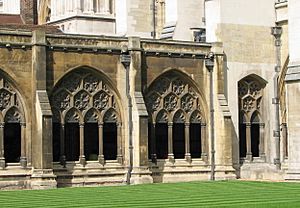
The following are buried in the cloisters:
- Edmund Ayrton
- Aphra Behn
- Gen. John Burgoyne
- Muzio Clementi
- Benjamin Cooke
- Robert Cooke
- Percy Dearmer
- Lord Fraser of Lonsdale
- Howard Nixon
- John Parsons
- Johann Peter Salomon
- William Shield
- Herbert Thorndike
- John Thorndike
- William Turner
- James Wright
North Choir Aisle
The following are buried in the North Choir Aisle:
- John Blow
- Henry Purcell
- John Robinson
- Admiral Edward Spragge
- Ralph Vaughan Williams
- William Sterndale Bennett
South Choir Aisle
The following are buried in the South Choir Aisle:
- Andrew Bell
- James Kendall
- Sir Paul Methuen
- Admiral Sir Cloudesley Shovell
- Dame Sybil Thorndike
- Charles Whitworth, 1st Baron Whitworth
Ambulatory chapels
The following are buried in the ambulatory chapels:
St. John the Baptist Chapel
- Sir Thomas Cecil, 1st Earl of Exeter, KG, Lord Burghley (d. 1623)
- Lady Dorothy Neville Cecil (d. 1608; 1st wife of Sir Thomas Cecil, daughter of John Neville, 4th Baron Latimer)
St. Nicholas' Chapel
Northumberland Vault
List of burials:
- George Seymour, Viscount Beauchamp (d. 1745; only son of Algernon Seymour, 7th Duke of Somerset)
- Algernon Seymour, 7th Duke of Somerset (d. 1750)
- Frances Percy, Née Thynne, Duchess of Somerset, (d. 1754; widow of 7th Duke)
- Lady Elizabeth Anne Frances Percy, (d. 1761; daughter of the 1st Duke of Northumberland)
- Elizabeth Percy, Née Seymour, Duchess of Northumberland (d.1776)
- Lady Elizabeth Percy, (d. 1779; daughter of Algernon Percy, 1st Earl of Beverley, at the time styled Lord Algernon Percy)
- Lady Charlotte Percy, (d. 1781; daughter of Hugh Percy, 2nd Duke of Northumberland, at the time styled Earl Percy)
- Hugh Percy, 1st Duke of Northumberland, (d. 1786)
- Lord Henry Percy, (d. 1794; son of Hugh Percy, 2nd Duke of Northumberland)
- Lady Louisa Margaret Percy, (d. 1796; daughter of Algernon Percy, 1st Earl of Beverley)
- Lord Algernon James Percy, (d. 1805; son of George Percy, 5th Duke of Northumberland, at the time styled Lord Lovaine)
- Lord Henry Algernon Pitt Percy, (d. 1809; son of George Percy, 5th Duke of Northumberland, at the time styled Lord Lovaine)
- Lady Margaret Percy, (d. 1810; daughter of George Percy, 5th Duke of Northumberland, at the time styled Lord Lovaine)
- Isabella Susanna Percy, Née Burrell, Countess of Beverley, (d. 1810; Widow of Algernon Percy, 1st Earl of Beverley)
- Hugh Percy, 2nd Duke of Northumberland (d. 1817)
- Lady Elizabeth Percy, (d. 1820; daughter of Hugh Percy, 2nd Duke of Northumberland)
- Frances Julia Percy, Née Burrell, Duchess of Northumberland, (d. 1820; 2nd wife of the 2nd Duke of Northumberland)
- Hugh Percy, 3rd Duke of Northumberland (d. 1847)
- Lady Agnes Buller, Née Percy, (d. 1856; daughter of Hugh Percy, 2nd Duke of Northumberland; wife of Major General F.T. Buller)
- Algernon Percy, 4th Duke of Northumberland (d. 1865)
- Charlotte Florentia Percy, Née Clive, Duchess of Northumberland, (d. 1866)
- George Percy, 5th Duke of Northumberland, (d. 1867)
- General Lord Henry Hugh Manvers Percy VC KCB, (d. 1877)
- Lady Louisa Percy, (d. 1883; daughter of George Percy, 5th Duke of Northumberland)
- Louisa Percy, Née Drummond, Duchess of Northumberland, (d. 1890; wife of Algernon George Percy, 6th Duke of Northumberland)
- Algernon George Percy, 6th Duke of Northumberland, (d. 1899)
- Alan Ian Percy, 8th Duke of Northumberland (d. 1930)
- Helen Magdalen Percy, Née Gordon-Lennox, Duchess of Northumberland, (d. 1965)
- Hugh Algernon Percy, 10th Duke of Northumberland, (d. 1988)
- Elizabeth Diana Percy, Née Montagu Douglas Scott, Duchess of Northumberland, (d. 2012) Ashes interred
St Paul's Chapel
- Katherine Percy, Née Neville, Countess of Northumberland, (d. 1596; daughter of John Neville, 4th Baron Latimer; wife of Henry Percy, 8th Earl of Northumberland)
- Sir Lewis Robessart (d. 1430), and his wife Elizabeth Bourchier, 4th Baroness Bourchier (died 1432)
Other ambulatory chapels
- Robert Aytoun
- Eleanor de Bohun
- Anne of Cleves
- Lionel Cranfield, 1st Earl of Middlesex
- John of Eltham, Earl of Cornwall
- Sir Rowland Hill
- Simon Langham
- Edward Talbot, 8th Earl of Shrewsbury
- William de Valence, 1st Earl of Pembroke
- Catherine of Valois
- George Villiers, 1st Duke of Buckingham
- Katherine Villiers, Duchess of Buckingham
- Sir Thomas Ingram, Chancellor of the Duchy of Lancaster and Privy Chancellor; son of Sir Arthur and Alice Ferrars Ingram of Temple Newsam in Yorkshire; 1672 (south ambulatory chapel, near the steps to the Lady Chapel)
- Frances Ingram, wife of Sir Thomas Ingram and daughter of Thomas Belasyse, Lord Viscount Fauconberg; 1680
- Mary Ingram, daughter of Sir Thomas and Frances Ingram; 1651
Henry VII's Lady Chapel
The following are buried in Henry VII's Chapel:
Antoine Philippe, Duke of Montpensier, brother of French King Louis Philippe I
- Joseph Addison (buried in a vault in North Aisle; also a white marble statue in Poets' Corner)
- Margaret Douglas, Countess of Lennox (buried, with her son Charles, in a tomb in South Aisle)
- Hugh Dowding, 1st Baron Dowding
- George Monck, 1st Duke of Albemarle (also memorial Henry VII Chapel, South Aisle)
- George Savile, 1st Marquess of Halifax
- Prince William, Duke of Gloucester (son of Queen Anne)
- Viscount Trenchard
- Maj. Gen. Charles Worsley (no memorial remains)
Unknown location
- Sir Arthur Ingram (1562-1642), son of Hugh and Anne Goldthorpe Ingram; buried 26 Aug. 1642; omission from main burial register during the English Civil War.
Memorials
The following are commemorated in the Abbey and/or had their Memorial Service in the Abbey, but were buried elsewhere:
Individuals
- Individuals memorialized in Westminster Abbey
-
"Placing the Canadian Colours on Gen. James Wolfe's Monument in Westminster Abbey" by Emily Warren
-
Old plaque for Robert Baden-Powell, now replaced with a new one also celebrating his wife, Olave
- Christopher Anstey, buried at St. Swithin's Church Bath, Somerset
- Dame Peggy Ashcroft, cremated at Golders Green Crematorium, London
- W. H. Auden, buried in Kirchstetten, Austria
- Jane Austen, buried in Winchester Cathedral, Hampshire
- Robert, Lord Baden-Powell, though his grave is in Nyeri, Kenya, and his wife Lady Olave Baden-Powell, whose ashes are also buried in Nyeri.
- Stanley Baldwin, cremated at Golders Green Crematorium and ashes buried in Worcester Cathedral, Worcestershire
- Admiral Robert Blake (on a stone memorial in the south choir aisle), initially buried in the Abbey but reburied in St Margaret's, Westminster in 1661.
- William Booth, buried at Stoke Newington, London Borough of Hackney
- Sir Adrian Boult, his body was willed to science
- Benjamin Britten, Baron Britten of Aldeburgh, buried at the parish church of Aldeburgh
- Charlotte Brontë, Emily Brontë, Anne Brontë; Charlotte and Emily are buried at Haworth, while Anne is buried at Scarborough, North Yorkshire
- Lord Byron, buried at Hucknall, Nottinghamshire
- Sir Henry Campbell-Bannerman, buried at Meigle, Perthshire
- Sir Winston Churchill, buried at Bladon, Oxfordshire
- John Clare, buried in St Botolph's churchyard, Helpston, Cambridgeshire
- James Cornewall, buried at sea off Toulon. His monument in the Abbey was the first ever to be erected by Parliament at public expense.
- Edward Cooke, buried in Calcutta, India
- Noël Coward, buried on the grounds of his home Firefly Estate in Jamaica
- William Cowper (in a stained glass window unveiled by George W. Childs in 1875), buried in East Dereham, Norfolk
- Diana, Princess of Wales, buried at Althorp, Northamptonshire
- Richard Dimbleby, buried in St Peter's churchyard, Lynchmere, West Sussex
- Paul Dirac, buried in Tallahassee, Florida
- Benjamin Disraeli, 1st Earl of Beaconsfield, buried at Hughenden Manor, Buckinghamshire
- Sir Francis Drake, buried at sea off Portobelo, Panama
- Sir Edward Elgar, buried in St Wulftan's RC Church in Little Malvern, Worcestershire
- Howard Florey, buried at Marston, Oxfordshire
- Sir John Franklin, presumably buried at sea near King William Island, Canada
- Adam Lindsay Gordon, buried in Australia
- George Green, mathematician, buried in his native Nottinghamshire.
- John Harrison, buried in St John's Church in Hampstead, North London
- Philip Larkin, buried Cottingham municipal cemetery near Hull
- Rev Evelyn Levett Sutton, prebendary of Westminster and chaplain to the House of Commons who collapsed after reading the ninth commandment during Sunday services and died the next day (in a monument)
- C. S. Lewis, buried in the churchyard of Holy Trinity Church, Headington, Oxford
- Jenny Lind, buried at Great Malvern, Worcestershire
- David Lloyd George, buried beside the River Dwyfor in Llanystumdwy, Carnarvonshire.
- Henry Wadsworth Longfellow, buried at Cambridge, Massachusetts
- George Herbert (in a stained glass window unveiled by George W. Childs in 1875)
- James Ramsay MacDonald, buried at Spynie, near Lossiemouth, Grampian
- Sir Robert Menzies, cremated in Australia
- Louis Mountbatten, 1st Earl Mountbatten of Burma, buried in Romsey Abbey.
- Pasquale Paoli, buried at Morosaglia, Corsica
- Arthur Phillip, buried at Bathampton, Somerset
- William Shakespeare, buried at Stratford-upon-Avon, Warwickshire
- Dylan Thomas (in a plaque unveiled in 1982), buried at Laugharne, Wales
- Thomas Totty, buried at Portsmouth Garrison Chapel, Portsmouth, Hampshire
- William Villettes, buried in Jamaica.
- Charles Wesley, buried at St Marylebone Parish Church, London
- John Wesley, buried at City Road Chapel, London
- Oscar Wilde (in a stained glass window unveiled in 1995), buried in Père Lachaise Cemetery, Paris
- Gen. James Wolfe, buried at St Alfege Church, Greenwich, South-East London
World War I poets
Sixteen Great War poets are commemorated on a slate stone unveiled 11 November 1985, in the South Transept (Poets' Corner):
- Richard Aldington, buried in Sury, Ardennes, France
- Laurence Binyon, author of "For the Fallen", buried in Reading, Berkshire
- Edmund Blunden, buried in Long Melford, Suffolk
- Rupert Brooke, author of "The Soldier", buried in Skyros, Greece
- Wilfrid Gibson, one of the Georgian poets
- Robert Graves, author of I, Claudius and the only poet of the sixteen still living at the time of the commemoration, buried in Deià, Majorca, Spain
- Julian Grenfell, buried in Boulogne-sur-Mer, France
- Ivor Gurney, buried in Twigworth, Gloucestershire
- David Jones, buried in Crofton Park, Lewisham
- Robert Nichols, buried in St Mary's Church, Lawford, Essex
- Wilfred Owen, author of "Dulce et Decorum est" and "Anthem for Doomed Youth", buried in Ors, France
- Herbert Read, buried in Stonegrave, North Yorkshire
- Isaac Rosenberg, buried in Pas-de-Calais, France
- Siegfried Sassoon, buried in Mells, Somerset
- Charles Sorley, also commemorated at the Loos Memorial in France
- Edward Thomas, buried in Agny Military Cemetery, France
20th-century martyrs
Above the Great West Door, ten 20th-century Christian martyrs from across the world are depicted in statues; from left to right:
 Maximilian Kolbe (d.1941)
Maximilian Kolbe (d.1941) Manche Masemola (d.1928)
Manche Masemola (d.1928) Janani Luwum (d.1977)
Janani Luwum (d.1977) Grand Duchess Elizabeth of Russia (d.1918)
Grand Duchess Elizabeth of Russia (d.1918) Martin Luther King Jr. (d.1968)
Martin Luther King Jr. (d.1968) Óscar Romero (d.1980)
Óscar Romero (d.1980) Dietrich Bonhoeffer (d.1945)
Dietrich Bonhoeffer (d.1945) Esther John (d.1960)
Esther John (d.1960) Lucian Tapiedi (d.1942)
Lucian Tapiedi (d.1942) Wang Zhiming (d.1973)
Wang Zhiming (d.1973)
Formerly buried (removed)
King Harold I was originally buried in the Abbey, but his body was exhumed and thrown into a fen in June 1040. The body was later rescued and re-buried in the church of St Clement Danes in Westminster.
A number of Cromwellians were also buried in the Abbey but later removed, in 1661, on the orders of King Charles II, and buried in a pit in St Margaret's churchyard, adjoining the Abbey. A modern plaque on the exterior wall of the church records the names of those who were disinterred:
In November 1869, at the request of the Dean of Westminster and with the approval of Queen Victoria, the philanthropist George Peabody was given a temporary burial in the Abbey, but later moved and buried in Salem, Massachusetts.
Proposed burials and memorials
- King Richard III burial: After the discovery of Richard III's remains in September 2012, a controversy arose as to whether or not King Richard should be interred at Westminster Abbey, where 17 other English and British kings are interred, or some other suitable location. His remains were ultimately buried in Leicester Cathedral.
- Captain Sir Tom Moore memorial: Following Moore's death on 2 February 2021, TV Presenter Carol Voderman suggested Moore should have a memorial stone placed in Westminster Abbey, in recognition of Moore's fundraising efforts in the run up to his 100th birthday during the COVID-19 pandemic.
Images for kids
See also
 In Spanish: Enterramientos y memoriales en la abadía de Westminster para niños
In Spanish: Enterramientos y memoriales en la abadía de Westminster para niños


